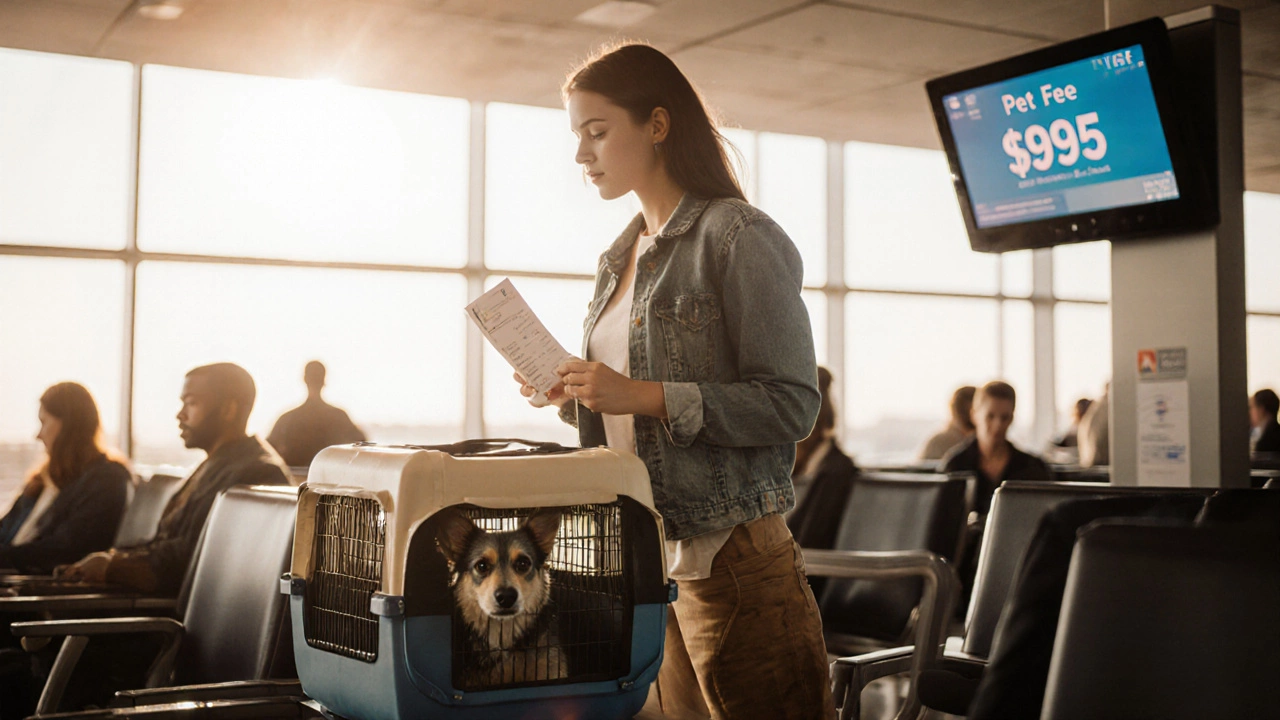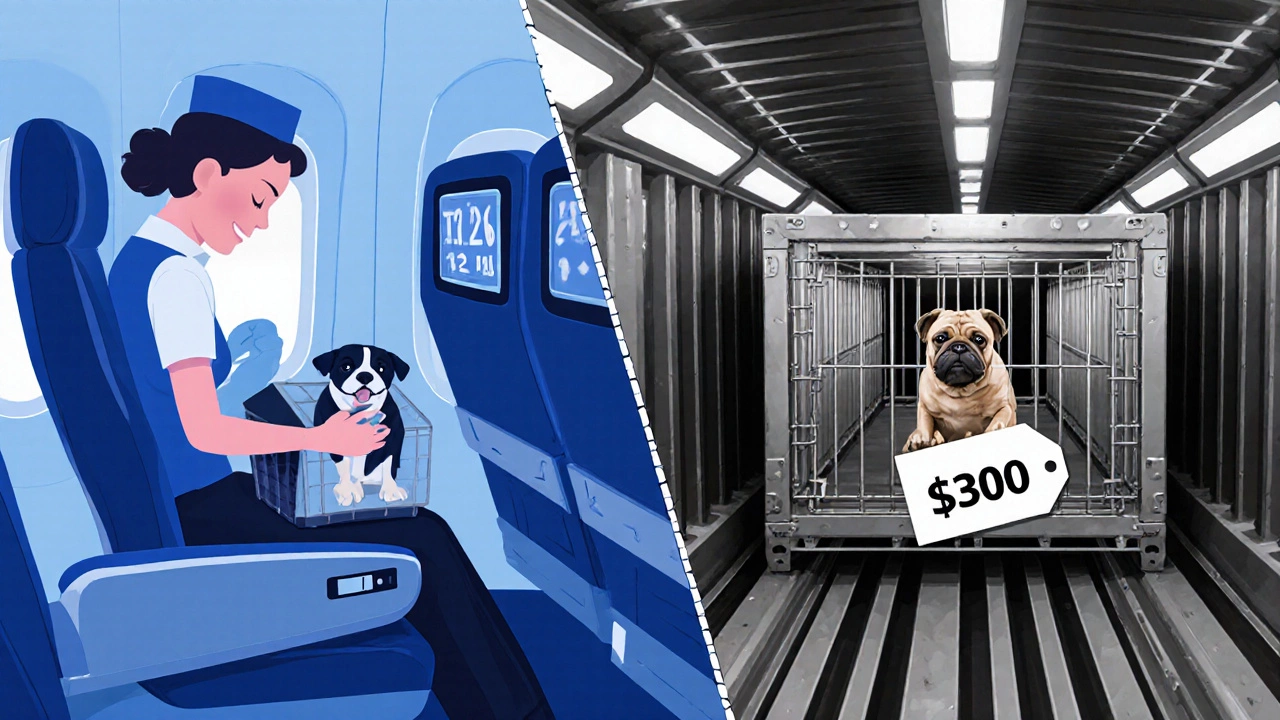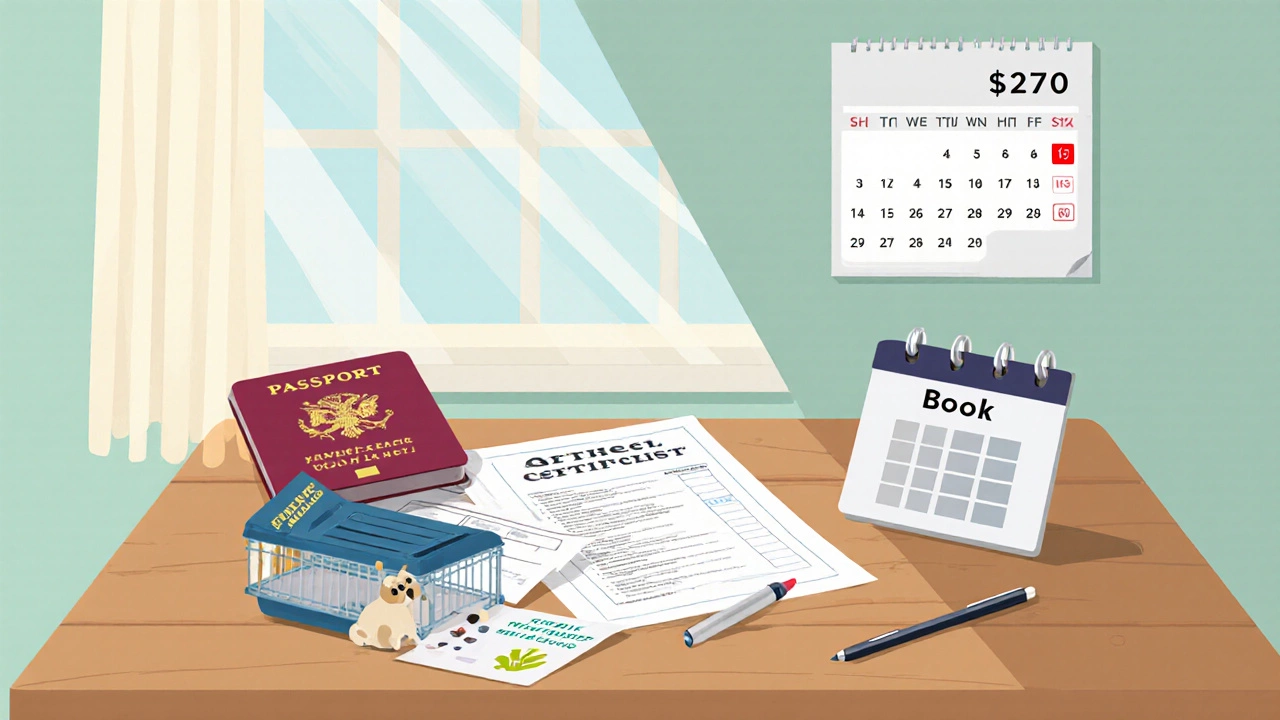
Pet Air Travel Cost Calculator
When you fly with a pet, the main charge you’ll see on the booking screen is the Airline Pet Fee, a fee airlines collect for transporting a live animal either in the cabin or as cargo. Knowing exactly what you’ll pay helps avoid surprise costs and lets you budget for a smooth trip.
Key Takeaways
- In‑cabin pet fees usually range from $30 to $125 per one‑way flight in the U.S.
- Checked‑baggage (cargo) fees can jump to $200‑$500, depending on size and destination.
- Health certificates, carrier purchase, and insurance often add $50‑$150 to the total.
- Each major U.S. airline has its own weight, size, and breed restrictions.
- Booking early, using the same airline for return trips, and joining loyalty programs can shave off up to 20% of the pet fee.
What Is an Airline Pet Fee?
The Airline Pet Fee is a non‑refundable charge that covers handling, safety checks, and the space your animal occupies on the plane. The fee is separate from your ticket price and is applied per pet, not per passenger.
Factors That Influence the Cost
Several variables determine whether you’ll pay $30 or $300 to bring your furry friend on board:
- Cabin vs. cargo: Small dogs and cats that fit under the seat can travel in the cabin, which is cheaper. Larger breeds must go as checked baggage or cargo, which is pricier.
- Weight and dimensions: Airlines set maximum combined weight (pet + carrier) and carrier size. Exceeding limits triggers higher fees or forces cargo travel.
- Domestic vs. international: International routes often require additional customs paperwork and higher handling fees.
- Season and demand: Peak travel periods (summer, holidays) may have stricter limits or surcharge fees.
- Breed restrictions: Some airlines prohibit brachycephalic (short‑snouted) breeds like Bulldogs or Pugs from flying in the cabin.
- Health documentation: A recent Pet Health Certificate is mandatory for most flights and adds vet visit costs.
Fee Breakdown of Major U.S. Carriers
| Airline | In‑cabin fee | Checked‑baggage (cargo) fee | Max weight (pet + carrier) | Carrier size limit (inches) |
|---|---|---|---|---|
| Delta Air Lines | $125 | $200‑$300 | 20lb (9kg) | 18L×11W×11H |
| American Airlines | $125 | $200‑$300 | 20lb (9kg) | 18L×11W×11H |
| United Airlines | $125 | $200‑$500 (depends on route) | 20lb (9kg) | 18L×11W×11H |
| Southwest Airlines | $95 | Not offered (cargo only for larger pets) | 20lb (9kg) | 18L×11W×11H |
| Alaska Airlines | $125 | $200‑$300 | 20lb (9kg) | 17L×11W×11H |

Hidden Costs You Can’t Ignore
Beyond the headline fee, most pet owners encounter additional expenses:
- Veterinary visit for health certificate: $50‑$100, depending on clinic and state regulations.
- Travel crate or Travel Crate: $30‑$120. Airlines require sturdy, airline‑approved crates for cargo travel.
- Pet travel insurance: Pet Travel Insurance policies range from $15‑$40 for a one‑way trip, covering cancellations and veterinary emergencies.
- Certificate and permit fees: International flights may need an import permit from the destination country, costing $20‑$60.
- Taxes and airport fees: Some airports assess a small surcharge (usually $5‑$10) for animal handling.
How to Save Money on Pet Flights
Here are proven tactics that keep the total under control:
- Book early: Airlines often limit the number of in‑cabin pets per flight. Early bookings lock in the lower fee before any seasonal increase.
- Use the same airline for round‑trip: Loyalty programs sometimes waive the pet fee on the return leg.
- Choose a smaller carrier: An airline‑approved carrier that just meets size limits avoids the cargo surcharge.
- Combine fees with a friend’s trip: Some airlines allow two pets for a single fee if they travel together, but verify policy first.
- Shop insurance wisely: Compare quotes from multiple providers; many credit‑card travel protections cover pets at no extra cost.
Step‑by‑Step Cost Calculator Example
Imagine you’re flying from LosAngeles (LAX) to NewYork (JFK) with a 12‑lb French Bulldog. Follow these steps:
- Check airline cabin eligibility. United, Delta, and American all allow a 12‑lb dog in‑cabin, so choose the cheapest cabin fee ($125).
- Add the health certificate: $75.
- Purchase a compliant carrier (18L×11W×11H) for $45.
- Optional pet travel insurance for a one‑way trip: $25.
- Total = $125 + $75 + $45 + $25 = $270.
Switching to cargo (due to a breed restriction) would change the fee to $300, add a larger crate ($90), and possibly raise the insurance premium, pushing the total above $420.

Common Pitfalls and How to Avoid Them
- Assuming the fee is refundable: It isn’t. If you cancel, the pet fee stays on the booking.
- Skipping the health certificate: Airlines will refuse boarding, and you could be stranded with a $200‑$300 re‑booking cost.
- Using a carrier that’s too big: You’ll be forced into cargo, which dramatically raises the price.
- Ignoring breed bans: Some airlines block snub‑nose breeds from cabin travel; double‑check before you book.
Pre‑Travel Checklist
- Confirm pet eligibility on the airline’s website.
- Reserve the pet spot when you buy your ticket (most airlines open a few weeks before departure).
- Get a current Pet Health Certificate (issued within 10 days of travel).
- Buy an airline‑approved Pet Carrier that meets weight and size limits.
- Consider Pet Travel Insurance for emergencies.
- Pack basics: water bowl, a small towel, and calming treats.
- Arrive at the airport at least 2hours early for domestic flights; 3hours for international.
Frequently Asked Questions
How far in advance should I book a pet spot?
Most U.S. airlines open pet reservations 48‑72 hours after the flight is listed. Booking as soon as you see the flight (often 30‑45 days out) guarantees the lower cabin fee.
Can I bring two pets on the same flight?
Yes, but each pet incurs a separate fee. Some airlines cap the number of in‑cabin pets per flight, so you may need to reserve early for both.
What if my pet gets sick during the flight?
A health certificate doesn’t guarantee a smooth trip. Having Pet Travel Insurance that covers veterinary expenses can save thousands in an emergency.
Do I need a separate ticket for my pet?
No, you don’t buy a separate seat. You add the pet fee during the reservation process, and the pet travels with you on the same flight.
Are there any airlines that don’t charge a pet fee?
All major carriers charge a non‑refundable fee. Some budget airlines may allow a pet in cabin for free but impose strict size limits and no cargo option, which can be riskier.


